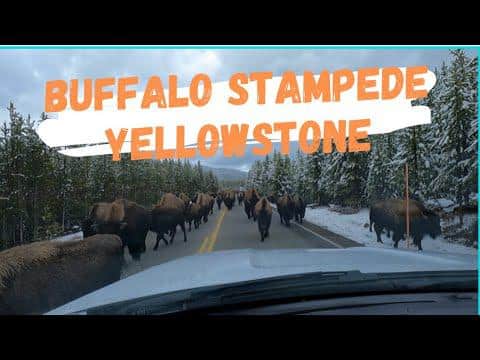
Yellowstone Visitors Shocked as 150+ Migrating Bison Surround Their Car

Every winter, the bison of Yellowstone National Park migrate up to 70 miles to lower elevations, and, this year, two astonished park visitors got caught in the middle of the journey.
YouTube user Broyles Outdoors posted a video October 31 showing more than 150 of the large mammals moving along the road towards and around their car.
“This is crazy,” a woman’s voice said as the bison approached the car. “They keep coming. Oh my gosh this is crazy.”
The video lasted for two minutes and fifty-seven seconds, showing several bison nearly headbutt the car’s front window before moving around the vehicle.
“This is a once in a lifetime,” a male voice said as a particularly massive bison approached. “That’s the Grand Poobah.”
The bison of Yellowstone National Park migrate twice each year, according to the national park. During the spring, most Yellowstone ungulates follow a “green wave” of new growth, but bison are a little different. They leave their winter ranges in time with the new vegetation, but they travel more slowly than the new shoots. This is because of their unique role in the Yellowstone ecosystem, the park explained:
Bison can move out-of-sync with forage green-up because they engineer the ecosystem. Rather than just moving to find the best foods, bison create high-quality foods by how they move and graze. When bison let the green wave pass them by, they spend their time returning to graze the same areas repeatedly at high intensity. The behavior keeps plants growing, although the plants never appear more than a few inches tall, and allows bison to keep getting highly nutritious foods.
When the snow begins to fall and accumulate, the bison move to lower elevations, and this is the migration caught in the video. The distance between the animals‘ summer and winter ranges is up to 70 miles, but all told bison travel about 1,000 miles over the course of the year as they leave and return to the same grazing areas. This makes them the most well-traveled ungulates in Yellowstone.
It is not uncommon for bison to make their journeys on the same roads used by human visitors, Yellowstone noted in a Facebook post. This makes it important to follow safety guidelines around wildlife when visiting the national park.
“Remember to drive cautiously, give them room – at least 100 yards (91 meters) from bears or wolves, and at least 25 yards (23 meters) from bison, elk, and other wildlife – and use a zoom lens!” the park advised.
[facebook https://www.facebook.com/YellowstoneNPS/photos/a.480329805315712/5175056082509704/ expand=1]
There were a total of 4,680 bison in Yellowstone in 2020, Newsweek reported. These are divided into two herds — the northern herd has more than 3,400 bison and the central herd has nearly 1,250. Male bison weigh up to 2,000 pounds, while female bison weigh about half that. A park spokesperson told Newsweek that bison injure more visitors than any other Yellowstone animal.
“Bison are unpredictable and can run three times faster than humans,” they said.

 233k
233k  41k
41k  Subscribe
Subscribe 